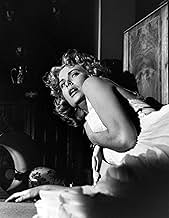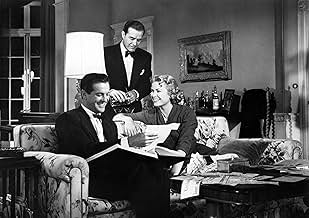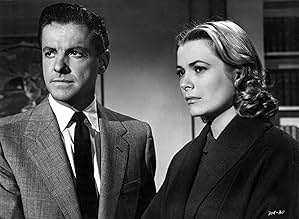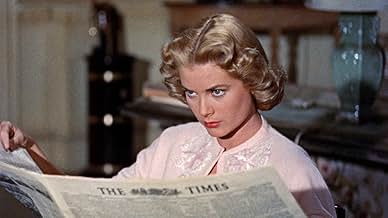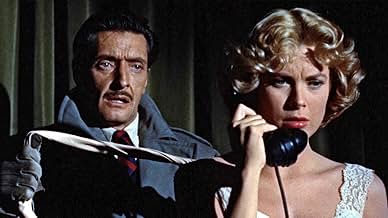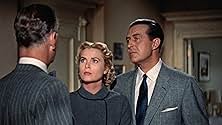Ein ehemaliger Tennisprofi schmiedet ein Komplott, seine Frau umzubringen. Als es misslingt, improvisiert er schnell einen Plan B.Ein ehemaliger Tennisprofi schmiedet ein Komplott, seine Frau umzubringen. Als es misslingt, improvisiert er schnell einen Plan B.Ein ehemaliger Tennisprofi schmiedet ein Komplott, seine Frau umzubringen. Als es misslingt, improvisiert er schnell einen Plan B.
- Nominiert für 1 BAFTA Award
- 5 Gewinne & 3 Nominierungen insgesamt
- Banquet Member
- (Nicht genannt)
- Detective
- (Nicht genannt)
- Bobby Outside Flat
- (Nicht genannt)
- Police Photographer
- (Nicht genannt)
- Detective
- (Nicht genannt)
- Woman Departing Ship
- (Nicht genannt)
- Banquet Member
- (Nicht genannt)
- Banquet Member
- (Nicht genannt)
Zusammenfassung
Empfohlene Bewertungen
Ray Milland (Tony Wendice) is a surprisingly sympathetic villain (which is perhaps not surprising from the actor with talent, charm, and charisma that equal and remind a lot of both Cary Grant and Jimmy Stewart) who knows about his wife cheating and decides to teach her a lesson by plotting a very clever murder which will make him a sole heir to her money (she is a wealthy one in the family). His plan is perfect and almost works but Margot managed to not only escape the murderer but to turn the table on him while stunned Wendice is on the phone and listens how his well thought of plan collapses. Wendice is very resourceful and he proved to be a master of improvisation because it took him a few minutes in a cab to switch to a plan B that turned a terrified victim Margot into a cold-blooded murderess. Now it is up to seasoned and shrewd inspector Hubbard (John Williams) to find the crucial piece of evidence and to solve the case.
As always with Hitchcock, his directing is impeccable, the camera rarely leaves Wendice's apartment but the film is never claustrophobic which is the case for many plays' adaptation. It breathes and moves freely and we almost forget that we are in the same room for close to two hours. I would not call "Dial M for Murder" my favorite Hitchcock's film but it is enjoyable, clever, and witty thriller with the interesting twists, outstanding performances, and more than one truly memorable scenes.
Cold Ray Milland plans and sets up the murder of his demure but faithless wife Grace Kelly by a virtual stranger who is urged on by the stick of exposure of his misdeeds and the carrot of GBP1,000 in used notes. Of course all of his convoluted plans go horribly or thankfully wrong, depending on your point of view, leading to an even more convoluted revised plan. When first seen when young I wasted my time because I wasn't paying attention at the critical moment so missed the point and didn't get it: the key is how did the baddie get into the apartment? It's incredibly verbose, being from a stage play after all and at times it seems nothing more than a radio show with pictures. The long scene setting and verbal sparring by Milland and Anthony Dawson is superb to hear - it's fascinating for its relentless poetry, and of displaying a now-dead world. I could never understand the attraction of 3D movies, least of all with this particular attempt, or why Kelly was continually uglified by the Hollywood machine when she never looked lovelier than in here when she was playing stressed out throughout.
I wonder if Hitch remembered the jokey murder scene he did in 1930 in Elstree Calling when Jameson Thomas realised he was murdering in the wrong apartment? Turn that key you have and go in, it's a remarkably literate film and as intricate inside as any lock.
But the dialogue, put on film here, is exceptional. I write this review having seen "Dial M for Murder" two or three times and wanting to see it once again. Many reviewers, myself included, have tried watching films with the sound off. I want to try the opposite. I want to close my eyes and just listen to the dialogue because it's so strong. The MacGuffin conversation at the beginning, with a perfectly cast Ray Milland blackmailing a perfectly cast Anthony Dawson into murdering a perfectly cast Grace Kelly is brilliantly written by Mr. Knott. It was clearly from a stage production, as it explains the plot background in great detail, and goes on for the better part of twenty minutes. Both men are fleshed out, giving us their personalities and individual tendencies. And even though "Dial M for Murder" pretty much stays on just one small set (an apartment in London, in which we see mostly the foyer, a little of the bedroom, and just a glimpse of the kitchen), what happens there is so fascinating that we do not really want to venture out into the city.
And that is just the setup. The dialogue remains insistently interesting and clever throughout the picture. It also has that subtle, dark sense of humor that Alfred Hitchcock was keen on. It also has the ironic touches, such as when Mr. Milland, as the jealous husband, kisses his unfaithful wife on the night she is to be murdered, and tells her: "Goodbye, my dear." The audience, having been given every single little detail about the scheme and how it is to unfold, cringes with a dark realization that Mr. Hitchcock might just go through with Mr. Milland's plot. Mr. Hitchcock, as the director, is also due tremendous credit for his trademark of creating tension. Screenwriter Knott brilliantly lays out for the audience, not the victim, how the murder will go through, but Mr. Hitchcock's camera dutifully follows everything as the scheme goes along. And, before we realize it, if something starts to go wrong, we become scared and tense. And you can imagine my guilt when I realized I was feeling scared that a plan to murder someone just might not go through. It's Mr. Hitchcock's gift at work.
Dimitri Tiomkin, a very good film composer, hits all the write notes; that includes knowing when he needs to tell his violins and trumpets to shut up. Robert Burks' cinematography is also strong with effective usage of shadows and streaks of light. Colors are omnipresent. And even though "Dial M for Murder" was shot with the intent to be seen in 3D, it is hardly evident. When I first saw the film, in much superior 2D, I did not mind the lamps and such in the foreground, such as when one bisects the screen between Ray Milland and Anthony Dawson during the opening sequence. I just thought it was a clever piece of filmmaking and misc en scene, not a cheap gimmick like in most 3D movies today. "Dial M for Murder" is a near-perfect movie of its kind, pumped full of smart dialogue and dazzling energy. This is one of the few play-to-movie transition that I have seen where I have suddenly become eager to see the original stage production.
Hands down the father of noir-film.
However. it actually has a lot going for it, being beautifully shot in luminous colour, extremely well acted in almost every role and peppered throughout with those eye-catching and brain-satisfying flourishes which so distinguished the director from the rest.
Yes, it is very set-bound, betraying its stage origins and likewise very talky, especially on exposition, but it keeps the viewer alert throughout and delivers a neatly satisfying conclusion. I do wish Hitchcock could have done better with his back-projection unit (an old-fashioned, jarring trait he still hadn't grown out of by "Marnie" some 10 years later) and I occasionally found the constant too frivolous background music an intrusion, but it's well paced throughout, helped considerably by an on-form cast.
Ray Milland is excellent in a kind of darker Cary Grant type persona, Grace Kelly (who'd want to murder her?) goes convincingly from loveliness to wretchedness while it's pleasing to see Robert Cumming to the fore, recalled by Hitch for the first time in over a decade (since "Saboteur" in 1942). The actors playing the would be murderer and nosey police inspector are just fine too.
About those flourishes..., perhaps the most famous being the changing spotlight on Grace Kelly's doomed face as her trial is condensed into just a few terse minutes and of course the murder scene itself, even if one can't imagine her extended stabbing gesture being strong enough to cut through Swann's jacket far less kill him stone dead, but I also enjoyed the raised tracking shot looking down on Milland as he explains his plot to Swann and particularly the parting shadows of lovers Cumming and Kelly at Milland's unexpected approach.
Yes, it's old fashioned Hollywood movie-making, but it's old-fashioned Hollywood movie-making at its best and in my opinion an unjustly overlooked effort from the Master.
Wusstest du schon
- WissenswertesJohn Williams won the 1953 Tony Award for Best Featured Actor in a Play for "Dial M for Murder" as Inspector Hubbard. He re-created the role in this movie.
- PatzerWendice throws a £100 bundle on a pink armchair. The money falls right at the back of the seat. A few minutes later, Swann takes the money which is now right in front of the armchair.
- Zitate
Tony Wendice: How do you go about writing a detective story?
Mark Halliday: Well, you forget detection and concentrate on crime. Crime's the thing. And then you imagine you're going to steal something or murder somebody.
Tony Wendice: Oh, is that how you do it? It's interesting.
Mark Halliday: Yes, I usually put myself in the criminal's shoes and then I keep asking myself, uh, what do I do next?
Margot Mary Wendice: Do you really believe in the perfect murder?
Mark Halliday: Mmm, yes, absolutely. On paper, that is. And I think I could, uh, plan one better than most people; but I doubt if I could carry it out.
Tony Wendice: Oh? Why not?
Mark Halliday: Well, because in stories things usually turn out the way the author wants them to; and in real life they don't... always.
Tony Wendice: Hmm.
Mark Halliday: No, I'm afraid my murders would be something like my bridge: I'd make some stupid mistake and never realize it until I found everybody was looking at me.
- Crazy CreditsThe title is shown on a background of a British telephone dial; its MNO marking is replaced by a single large M which forms the single M of the title.
- Alternative VersionenThe film had an intermission in its original 3-D release, although it is less than two hours in length.
- VerbindungenEdited into Geschichte(n) des Kinos: Le contrôle de l'univers (1999)
Top-Auswahl
Details
- Erscheinungsdatum
- Herkunftsland
- Sprache
- Auch bekannt als
- Con M de Muerte
- Drehorte
- Produktionsfirma
- Weitere beteiligte Unternehmen bei IMDbPro anzeigen
Box Office
- Budget
- 1.400.000 $ (geschätzt)
- Bruttoertrag in den USA und Kanada
- 24.845 $
- Eröffnungswochenende in den USA und in Kanada
- 12.562 $
- 11. Apr. 1999
- Weltweiter Bruttoertrag
- 45.313 $
- Laufzeit1 Stunde 45 Minuten
- Farbe
- Seitenverhältnis
- 1.66 : 1
Zu dieser Seite beitragen




